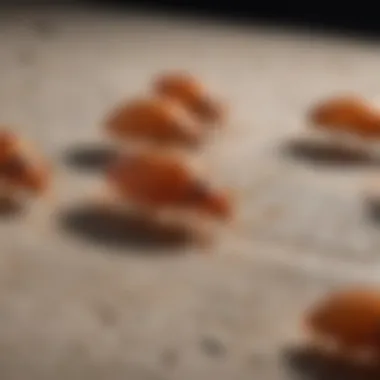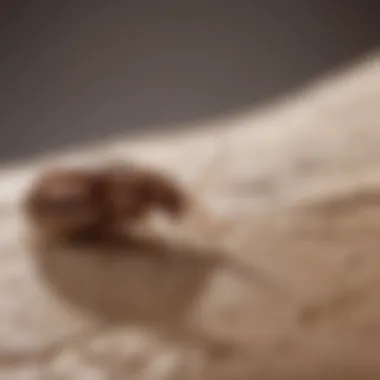The Lifespan of Bed Bug Eggs: Duration & Management


Intro
Understanding the lifespan of bed bug eggs is critical for effective pest management. Bed bugs, scientifically known as Cimex lectularius, are resilient insects that have adapted well to human environments. Their reproductive patterns, especially concerning egg longevity, play a significant role in the persistence of infestations. This article will offer insights into the duration of bed bug eggs under various conditions, how factors such as temperature and humidity affect their survival, and what implications this has for effective pest control strategies.
Pest Identification
To tackle bed bug infestations effectively, it is crucial first to identify these pests and their signs. This section will delve into how to recognize bed bugs and detect their presence in your home.
Common Household Pests
Bed bugs are often mistaken for other pests, which can complicate identification. Here are some characteristics:
- Appearance: Adult bed bugs are reddish-brown and about the size of an apple seed. They have flat bodies, oval shapes, and no wings.
- Lifestyle: Bed bugs prefer warm places, often hiding in mattresses, bedding, and furniture during the day, coming out at night to feed on human blood.
Signs of Infestation
Recognizing signs of a bed bug infestation is vital for early intervention. Key indicators include:
- Bite Marks: Red, itchy welts on exposed skin, often arranged in a line or cluster.
- Stains: Dark spots on sheets or mattresses indicating blood spots or excrement.
- Shed Skins: Bed bugs molt, leaving behind exoskeletons that resemble the adult bugs.
"Identifying bed bugs early can significantly reduce the duration and complexity of control efforts."
Egg Lifespan Overview
Understanding how long bed bug eggs can last is essential for successful pest management. Female bed bugs can lay anywhere from one to five eggs daily, often depositing them in hidden locations. Eggs are typically about 1 mm in size and white in color.
Under ideal conditions, bed bug eggs can hatch in about 6 to 10 days. However, longevity can vary, especially in unfavorable environments. In lower temperatures or high humidity, they may survive longer, complicating eradication efforts.
Implications of Egg Longevity
The ability of bed bug eggs to withstand adverse conditions highlights the importance of a multi-faceted approach to pest control. An understanding of their biology can inform targeted strategies that disrupt their life cycle.
Household measures that disrupt the environments conducive to reproduction will significantly benefit any control methods.
Prevention Methods
Prevention is crucial to combat bed bug infestations and requires attention to environmental factors.
Environmental Modifications
Adjustments in your living space can minimize the risk of bed bug infestations:
- Declutter: Remove unnecessary items that can serve as hiding places.
- Seal Cracks: Ensure that walls, baseboards, and floors are sealed to prevent bugs from entering.
Home Maintenance Tips
Regular maintenance can ensure a lower risk of infestations:
- Vacuum Regularly: Use a vacuum, especially around beds and carpets, to remove bed bugs and eggs.
- Wash Bedding: Regularly washing bed linens in hot water can kill both bugs and their eggs.
DIY Pest Control Solutions
For those seeking immediate solutions, there are several DIY methods that can be effective against bed bug populations.
Natural Remedies
Some common natural remedies include:
- Diatomaceous Earth: This powder damages the outer shell of bed bugs, leading to dehydration.
- Essential Oils: Oils like lavender and tea tree oil may repel bed bugs, although effectiveness varies.


DIY Traps and Barriers
Creating traps can help monitor and control populations:
- Interceptor Traps: Place traps under bed legs to catch bugs as they attempt to climb.
- Double-Sided Tape: A temporary barrier to catch bugs before they reach your bedding.
The Biology of Bed Bugs
Understanding the biology of bed bugs is crucial for several reasons. First, by comprehending their features and behaviors, house owners can more effectively identify and manage potential infestations. Bed bugs, scientifically known as Cimex lectularius, are small, nocturnal insects that feed on the blood of humans and other warm-blooded hosts. Their presence in homes can lead to discomfort, anxiety, and sometimes even health issues. Knowing their biological aspects aids in recognizing the signs of infestation and taking proactive measures to combat it.
Bed bugs are particularly notorious for their ability to reproduce quickly. Understanding their reproductive rate and methods allows home owners to anticipate future outbreaks and implement strategies that address these pests effectively. Additionally, awareness of their life cycles is vital in determining the most suitable treatment measures.
Identification of Bed Bugs
Identifying bed bugs accurately is the first step in dealing with an infestation. Adult bed bugs are roughly the size of an apple seed, oval, and brownish in color. However, their eggs, which are about 1 millimeter in size, are small and white, making them harder to spot. Signs of a bed bug presence include:
- Bite marks on the skin: These are often in clusters or lines and can cause itching.
- Dark spots on bedding: These are fecal spots that indicate bed bug activity.
- Shed skins: Bed bugs molt several times throughout their life cycle, leaving behind exoskeletons.
Recognizing these signs requires vigilance, especially in areas where people sleep or relax. Awareness of their characteristics is essential to maintaining a pest-free environment.
Understanding Bed Bug Life Cycles
The life cycle of bed bugs consists of several stages: egg, nymph, and adult. An understanding of these stages emphasizes the importance of treating infestations comprehensively.
- Egg: Bed bugs lay around 1 to 5 eggs daily, usually in hidden areas. These eggs hatch in about 6 to 10 days.
- Nymph: After hatching, the young bed bugs, or nymphs, go through five molts before becoming adults. This stage can last from weeks to months, depending on environmental conditions.
- Adult: Once they reach maturity, they can reproduce quickly, exacerbating the infestation problem.
The entire life cycle, from egg to adult, can occur within a month under optimal conditions. Understanding these cycles enables effective pest control measures.
"Knowledge of the bed bug life cycle is essential for implementing the right pest management strategies."
In summary, recognizing how bed bugs live and reproduce equips home owners with the knowledge needed to tackle infestations. Identifying the signs of bed bugs and understanding their life cycle are foundational elements in maintaining a bed bug-free home.
Reproductive Patterns of Bed Bugs
The reproductive patterns of bed bugs play a crucial role in understanding their lifecycle and management. These patterns influence the population dynamics of infestations, which can become significant if not addressed. The knowledge of how bed bugs mate and lay eggs is essential for enacting effective pest control strategies.
Mating Behaviors
Bed bugs exhibit a unique form of mating behavior known as traumatic insemination. During this process, the male bed bug pierces the female's abdomen with his reproductive organ and deposits sperm directly into her body cavity. This unusual mating method allows the male to bypass traditional pathways, but it can be harmful to the female.
After mating, the female bed bug stores the sperm and can fertilize her eggs over time. This process ensures that a single mating event can result in multiple batches of eggs being laid. The female’s capacity to store sperm affects the overall reproductive success and contributes to the rapid population growth characteristic of bed bug infestations.
Key points regarding mating behaviors include:
- Traumatic Insemination: This is a distinctive characteristic of bed bug reproduction.
- Sperm Storage: Females can fertilize eggs over an extended period, leading to multiple hatches.
- Impact on Infestation Risks: Understanding these behaviors can aid in predicting and preventing potential infestations.
Egg Laying Habits
The egg-laying habits of bed bugs are significant for indicating potential infestation. A female bed bug lays an average of 5 to 7 eggs per day, potentially producing hundreds of eggs in her lifetime. The eggs are small, white, and often resemble grains of rice, making them challenging to detect in various environments.
Bed bugs prefer to lay their eggs in hidden and undisturbed areas where they can remain concealed from potential threats. Common locations include bed frames, mattress seams, and cracks in furniture. Factors such as temperature and humidity can affect the egg-laying frequency and the subsequent development of the eggs into nymphs.
Important facts about bed bug egg-laying habits include:
- Average Egg Production: A female can lay up to 500 eggs throughout her life.
- Preferred Locations: Eggs are typically hidden in dark, secluded spaces to ensure protection from predators.
- Conditions Affecting Egg-laying: Environmental factors are crucial for optimal reproduction and increase the rate at which eggs are laid.
Understanding the reproductive patterns of bed bugs is essential for effective pest control strategies. Knowing their mating behaviors and egg-laying habits aids in taking appropriate measures to mitigate infestations.
Lifespan of Bed Bug Eggs


Understanding the lifespan of bed bug eggs is crucial for managing and controlling infestations. Bed bugs reproduce rapidly, and knowing how long their eggs can survive helps in formulating effective pest control strategies. A thorough grasp of egg longevity also sheds light on the timing of treatment interventions, as it highlights the critical phases in the bed bug life cycle where targeted actions can make a significant impact.
The focus is on specific elements like temperature, humidity, and the availability of hosts, as these factors can vary greatly in domestic environments or various settings. Active monitoring and preventive measures can be better established by understanding the average lifespan of bed bug eggs. This knowledge empowers homeowners and pest control professionals to act decisively in mitigating risks associated with infestations, ultimately leading to healthier living spaces.
Average Lifespan
Bed bug eggs typically hatch within a time frame of six to ten days, depending on various environmental conditions. Under optimal circumstances, a warm room provides a suitable environment for these eggs to progress through their life cycle. However, eggs may survive longer in suboptimal conditions, extending their lifespan significantly. It is not uncommon for eggs to lie dormant until conditions improve, thereby waiting for a more favorable environment for hatching. This aspect of egg survival highlights the adaptive nature of bed bugs and underscores the importance of including unused areas in pest control measures.
Factors Influencing Lifespan
Temperature effects
Temperature is a pivotal factor affecting the lifespan and development of bed bug eggs. At temperatures above 70 degrees Fahrenheit, eggs develop faster and hatch more quickly. Conversely, cooler environments prolong the duration before hatching. The duality of temperature's influence on bed bug development emphasizes its crucial role in pest management. Cold conditions may slow the hatch rate, but they can also protect the eggs by prolonging their viability. Striking a balance in temperature control in infested areas can enhance treatment effectiveness.
Humidity impact
Humidity is another critical element that affects the lifespan of bed bug eggs. A humid environment can trigger quicker hatching, while dry conditions may lead to prolonged egg viability. The ideal humidity levels for bed bugs typically range from 40% to 70%. If humidity is too low, it may decrease hatching rates, but excessive humidity does not guarantee survival either. For effective extermination, a strategic approach to humidity regulation can aid in enhancing control methods, ensuring conditions are less hospitable for breeding.
Host availability
The presence of hosts plays a significant role in the overall dynamics of bed bug populations. When hosts are readily accessible, it can encourage females to lay more eggs and potentially hasten the hatching process. Conversely, if hosts are scarce, egg viability may increase as females delay laying until conditions are better. This adaptability means eggs can wait for optimal circumstances before hatching. It also indicates the necessity for thorough inspections in areas often frequented by humans or pets, ensuring that all possible hosts are accounted for in pest control measures.
Understanding these factors provides vital insights for homeowners and professionals alike in their quest to manage and eliminate bed bug infestations effectively.
Dormancy and Survival Mechanisms
Understanding the dormancy and survival mechanisms of bed bug eggs is crucial for anyone dealing with infestations. This section highlights the resilience of these eggs, detailing how they endure various environmental challenges. The ability of bed bug eggs to remain inactive for extended periods underscores the importance of effective pest control. Recognizing how these eggs survive can aid in developing strategies to prevent infestations and manage existing problems.
Survival in Harsh Conditions
Bed bug eggs have developed remarkable adaptations that allow them to survive in inhospitable environments. These adaptations mean they can endure conditions that would normally be lethal to many other species. For instance, during cold temperatures, bed bug eggs can enter a dormant state. In this state, their metabolic processes slow down dramatically, allowing them to withstand freezing temperatures that might disrupt normal cellular functions.
Furthermore, in extreme heat, bed bug eggs can also exhibit resilience. They can tolerate temperatures rising significantly above the normal range, as long as these conditions are not prolonged. In fact, studies have shown that heat treatments are among the most effective control methods, as they can effectively eliminate many life stages of bed bugs but can be challenging when targeting eggs specifically, due to their survival capabilities.
"Understanding the survival traits of bed bug eggs is essential for developing effective control strategies. It highlights the challenges pest managers face when attempting to eradicate bed bug infestations."
Effects of Environmental Stressors
Environmental stressors play a vital role in determining the lifespan and viability of bed bug eggs. Factors such as temperature fluctuations, humidity, and even host availability can significantly impact their dormancy and survival rates. Here are some key points to consider:
- Temperature Variability: Bed bug eggs thrive at specific temperature ranges. Extreme heat below 113°F or cold below 46°F leads to an increase in mortality rates. However, within tolerable limits, they can successfully remain dormant.
- Humidity Levels: High humidity can be beneficial for bed bug eggs, aiding in their development. Conversely, lower humidity may lead to desiccation, impairing their chance of survival.
- Host Availability: The presence of a host significantly influences the egg's viability. With adequate food sources, the likelihood of successful hatching increases. Conversely, absence of hosts can lead to a drop in the population.
Recognizing these environmental influences allows homeowners to adjust their prevention strategies. By controlling temperature and humidity levels, it is possible to create an environment that is less favorable for bed bug egg incubation and survival.
Implications for Pest Control
Understanding the lifespan of bed bug eggs is crucial for effective pest control strategies. Knowledge of how long these eggs can survive under varying conditions helps in formulating timely and strategic interventions. The ramifications of failing to consider the duration of bed bug eggs go beyond mere inconvenience. Infestations can escalate rapidly if control measures are not executed effectively. Therefore, comprehending the implications of egg longevity is paramount for both homeowners and pest control professionals.
Timing of Control Measures
Understanding life cycle stages
The understanding of life cycle stages is key in pest control efforts against bed bugs. Bed bugs undergo five nymphal stages before they reach adulthood. Each of these stages presents an opportunity for targeted treatment. Knowing when the eggs hatch and when nymphs are present helps establish effective timing for control measures. This knowledge allows homeowners to synchronize treatments with the most vulnerable stages in the bed bug’s life cycle, thus maximizing their effectiveness.
A key characteristic of this understanding is the cyclical nature of bed bug life. Since eggs hatch into nymphs within about seven to 10 days, treatment immediately after egg hatching can significantly reduce bed bug populations. This is a beneficial strategy as it directly targets the new generation of pests.
However, a unique feature lies in the dormancy of bed bug eggs under unfavorable conditions. If conditions improve, dormant eggs can hatch even after long periods. This highlights a disadvantage: treatment timing must be precise, or previously dormant eggs may revive and lead to a rebirth of the infestation.
Strategic treatment timing


Strategic treatment timing focuses on executing pest control measures based on the life cycle of bed bugs. This aspect takes into account potential overlaps in the life stages of bed bugs and the environmental conditions that may influence their survival. For instance, implementing treatments during peak activity periods—typically in warmer months—ensures a higher likelihood of success.
One defining feature of strategic timing is that it requires careful monitoring and planning. Treatment strategies can be adjusted based on the observed life cycle stages within an infestation. This adaptability is particularly advantageous as it allows homeowners to respond quickly as situations change.
On the downside, this method can be resource-intensive. Frequent inspections and treatments may be necessary to accurately gauge the situation. Still, the benefits of well-timed interventions often outweigh the drawbacks, making this an effective choice for any pest control approach.
Effective Treatment Methods
Chemical options
Chemical options for controlling bed bugs are widely recognized for their rapid action and effectiveness. Various insecticides target bed bugs directly and can kill them upon contact or ingestion. Chemical treatment is often a preferred choice in infestations as it reduces bed bug populations significantly when applied correctly. The key characteristic of chemical treatments is their ability to provide immediate relief from the infestation.
However, a unique feature of using chemicals is the risk of resistance developing in bed bug populations. Over time, some bed bugs may adapt to the chemicals used, which can render them ineffective. This limitation highlights the importance of rotating different chemical classes to prevent resistance.
Non-chemical strategies
Non-chemical strategies involve methods that do not utilize pesticides, focusing on physical removal and environmental modifications. Approaches such as vacuuming, steam treatment, and mattress encasements are effective in managing infestations without chemical exposure. This option is increasingly appealing due to concerns about chemical residues and health implications associated with pesticide use.
The key characteristic of non-chemical strategies is their effectiveness in conjunction with chemical methods. They help in eliminating bed bugs at various life stages, particularly eggs and nymphs. A unique feature is their ability to target areas where chemicals may not reach effectively, thereby enhancing overall control measures.
However, one disadvantage is that non-chemical strategies often require considerable time and effort. Homeowners must commit to ongoing monitoring and maintenance to achieve lasting results. Despite this, they offer a comprehensive approach that can significantly enhance pest control effectiveness when combined with other methods.
Understanding the lifespan of bed bug eggs and their life cycle is fundamental to effective pest control. Failure to account for these elements can lead to ineffective treatments and ongoing infestations.
Monitoring and Prevention Strategies
Monitoring and prevention strategies serve as vital components in managing bed bug infestations. Understanding the behavior and biology of these pests allows homeowners to take proactive steps toward protection and control. With the right strategies in place, resources can be optimized, leading to effective pest management, reduced anxiety, and a more comfortable home environment.
Effective monitoring can prevent a minor issue from escalating into a full-blown infestation. It is critical to catch bed bugs early, as their population can multiply rapidly due to their short life cycle. This requires regular inspection of potential hiding spots such as mattresses, bed frames, and furniture. Homeowners should be equipped with adequate knowledge and tools to identify signs of bed bugs, including:
- Blood spots on sheets or upholstery
- Dark fecal spots in hidden areas
- Empty egg casings or shed skins
By maintaining a diligent watch, homeowners can detect even the earliest signs of an infestation, allowing for quicker intervention, which may save significant time and costs associated with treatments.
Detection Techniques
Detection techniques focus on identifying bed bugs before they become a larger issue. There are several methods available that vary in effectiveness and efficiency:
- Visual Inspections: Regularly checking sleeping areas and surrounding furniture can reveal signs of bed bugs. Homeowners should look for live bugs, eggs, and feces.
- Use of Bed Bug Monitors: These devices can be placed around the bed area to trap bed bugs. Monitors can provide an early warning, aiding in quick action.
- Professional Inspections: For a more thorough assessment, homeowners may wish to hire pest control professionals, equipped with specialized tools and trained to identify signs of bed bugs.
Utilizing a combination of these methods can greatly enhance the chances of early detection and successful intervention.
Long-term Preventive Measures
Long-term preventive measures are essential for maintaining a bed bug-free environment, particularly after an eradication effort. It’s important to consider proactive actions to minimize the risk of future infestations:
- Regular Cleaning: Maintaining a clean home is crucial. Vacuuming frequently and washing bedding at high temperatures can eliminate potential bugs and eggs.
- Encasements: Using mattress and box spring encasements can prevent bed bugs from establishing a habitat. Encasements act as a barrier, trapping any existing bugs inside and preventing new ones from entering.
- Mindful Travel: Bed bugs often travel in luggage. Homeowners should inspect hotel rooms, keep luggage off the floor, and wash clothes upon returning home.
- Decluttering: Minimizing clutter reduces potential hiding spots for bed bugs, making both detection and cleaning easier.
Edifying oneself and implementing these preventive strategies create a more resilient household against bed bugs.
Intrusive and resilient, bed bugs require vigilance and dedication in monitoring. Act swiftly to prevent infestation.
End
Understanding the lifespan of bed bug eggs holds significance for effective pest control. Proper awareness of how long these eggs can survive assists in managing infestations efficiently. Adult bed bugs lay eggs which can endure varied conditions, impacting how long a problem lasts in a home.
Summary of Findings
In this article, we discuss how the average lifespan of bed bug eggs ranges from several days to weeks, influenced by environmental factors. High temperatures can accelerate the hatching process, while cooler conditions may prolong it. Humidity also plays a crucial role; too much or too little can hinder development. Furthermore, the availability of a host impacts egg longevity. When hosts are scarce, bed bugs may adapt by extending their life cycle.
Research indicates that an understanding of these factors can lead to more effective pest control strategies, enabling timely interventions to prevent widespread infestations.
Recommendations for Readers
- Monitor environmental conditions: Keep an eye on temperature and humidity in living spaces, as these directly affect bed bug egg viability. Use dehumidifiers or maintain consistent indoor climate.
- Implement preventive measures: Regular inspection of sleeping areas, including bedding and furniture, can help catch infestations early. Seal cracks and crevices where bed bugs may enter.
- Know when to act: If you suspect an infestation, consider contacting a pest control professional promptly. Understanding the life cycle of bed bugs aids in effective timing for treatments.
By grasping the complex dynamics surrounding bed bug eggs, readers can take proactive steps in safeguarding their homes from potential infestations.















